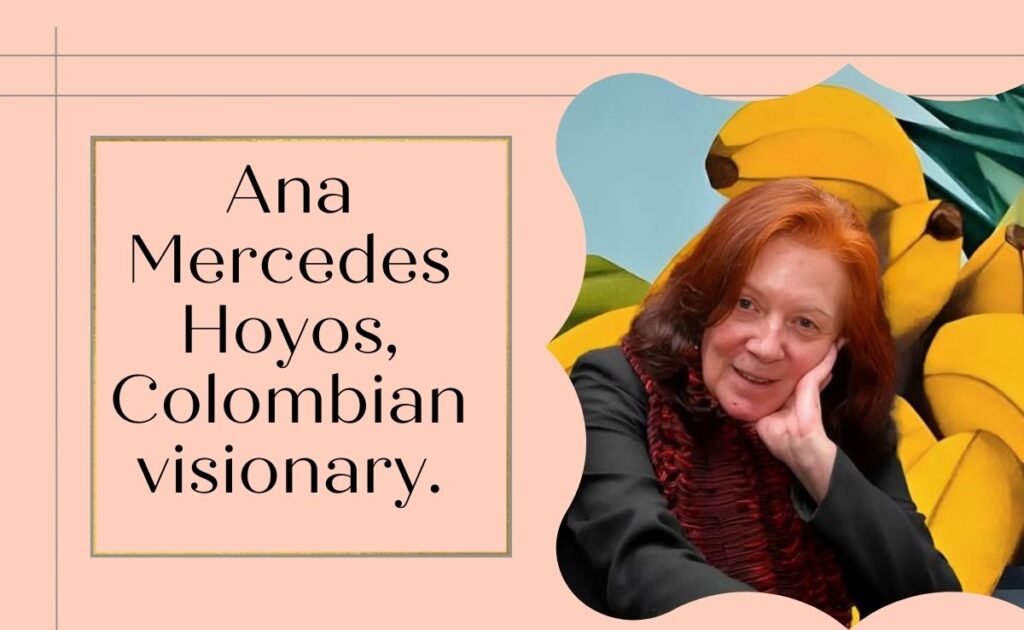Artist Ana Mercedes Hoyos was born in Bogota in 1942. She was recognized for her realistic paintings and loved Latin American culture and mythology. She received her education at the Universidad de los Andes in Bogota, Colombia, and then further her studies in the US.
Throughout her life, Hoyos took several trips; she lived in Europe and studied painting in Italy. She became known as a prominent figure in Colombian art after receiving several accolades, distinctions, and prizes. Her paintings are distinguished by vivid colours, bold lines, and expressive shapes, and they often include human characters, animals, and landscapes.
Ana Mercedes Hoyos often included Colombian cultural customs into her artwork, while remaining faithful to her Latina ancestry. She was driven to dispel the myth that Latin American artists solely produced political art, and she was successful in doing so by combining art and culture to produce a body of work that was both distinctive and powerful.
2014 saw Ana Mercedes Hoyos pass away. The narrative told in that show placed Hoyos at the front of a long line of artists—including Nelson Fory, Liliana Angulo, Trinidad Caballero Beaine, Fabio Melecio Palacios, and Mercedes Angola—who have studied negritude in Colombian society.
Curated by Camilo Chico Triana, Ana Mercedes Hoyos’ Aurora show took place in 2011 at the José Martí Memorial in Cuba. Upon seeing it, I comprehended the artistic endeavour of a person fervently dedicated to the legacy of her own Colombia and its African American community, particularly in San Basilio de Palenque. Afro-Colombian clothing details and references to the horrific transatlantic slave voyage were among the pieces I came across; however, it was the references to the slave trade, such as Commercial Trangle (2005), which outlines the routes taken by slave ships between Europe, Africa, and the Americas, that really drew my attention. Her early years spent surrounded by the murals of prominent Colombian artists, such Pedro Nel Gómez (1899–1948) and Santiago Martínez Delgado (1906–1954), had a profound impact on her enjoyment of large-scale, socially aware art. From then on, I became interested in Hoyos, an artist supported by Marta Traba during her lifetime and subsequently by art critics Eduardo Serrano and Edward J. Sullivan.
Influences
She experimented with a variety of artistic forms in her early career, but her investigation of abstraction and use of vivid colours signalled a turning point in her artistic development. Her early years spent surrounded by the murals of prominent Colombian artists, such Pedro Nel Gómez (1899–1948) and Santiago Martínez Delgado (1906–1954), had a profound impact on her enjoyment of large-scale, socially aware art.
Instruction and Early Works of Art
Hoyos continued her creative education in the School of Fine Arts of the National University of Colombia in Bogotá, where she developed her proficiency in a variety of mediums, such as printmaking and painting. In addition to honouring Colombian culture, these artworks tackled important environmental and social concerns.
Significant Career Accomplishments
Hoyos held the rare and distinguished position of Colombia’s Ambassador to UNESCO, which was bestowed upon him in 1993. Her Impact on General Art History The creative legacy of Ana Mercedes Hoyos has endured throughout Colombian and Latin American art history. Her bold use of colour, geometric abstraction, and socially conscious subjects inspired a new generation of artists who wanted to honour their ethnic background while using art to highlight global concerns. Her public works and murals are still a testimony to the ability of art to influence society narratives, enhancing cityscapes and cultural institutions.
Then was a conference held in relation to this exhibition, and it was then that we first spoke with her and got to know her well. She shared many experiences with her friends, her husband Jacques Mossier, and her daughter Ana. I had the good fortune to see her paintings from the 1960s and 70s at her home studio in the La Macarena neighborhood. These paintings include her well-known windows and her atmospheres, the latter of which are genuine masterpieces. During that time, Hoyos’ paintings were carefully chosen and included in the 2012 show La geometries Como pretext in Bogotá, organized by Asbell Suárez and Eduardo Serrano. This helped to give Hoyos the credit she deserves in the annals of Colombian art history. Hoyos was a well-known artist in Colombia, and his works went beyond simple beauty to depict the intricacies of the country’s civilization and tackle difficult societal concerns.
The Cultural Heritage of Colombia
Hoyos’s early exposure to the rich cultural legacy of Colombia had a significant impact on her aesthetic sensibility.
Her artwork prominently features the vivid hues and native crafts of her own country, honouring Colombia’s many customs and cultural identity. Her artistic endeavours aimed to conserve and enhance Colombia’s cultural legacy, cultivating a feeling of national pride and unity among her compatriots.
Social Interaction and Geometric Abstraction
Ana Mercedes Hoyos adopted geometric abstraction as her preferred creative technique in the 1960s. Her artwork prominently features the vivid hues and native crafts of her own country, honoring Colombia’s many customs and cultural identity. She addressed topics like poverty, injustice, and environmental degradation via her work by deftly incorporating socially aware themes into her geometric creations.
Obstacles and Achievements Throughout her creative career, Hoyos encountered both obstacles and achievements. Abstraction won her praise, but the establishment often resisted her socially controversial topics. She kept pursuing her job and never gave up on social justice. Her appointment as Colombia’s UNESCO ambassador enabled her to promote art and culture worldwide.



